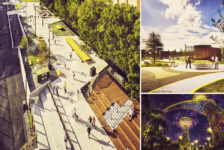Chinese artist Xu Bing creates two 12-ton phoenixes from materials collected found in Chinese construction sites, a striking visual commentary on the effects of China’s rapid commercial development on the country’s landscape. Check out the time-lapse video down below. (Colossal)
LANDSCAPE ARCHITECTURE
- Michael Van Valkenburgh Associates has been selected to work on updating the Menil Collection’s museum grounds in Houston, TX. The Renzo Piano-designed museum is renowned not only for its stunning collection of twentieth century art, but also for its lush park surroundings. (ArchDaily)
- Low-impact development has become a hot topic in light of recent climate change-induced disasters. From August 18 to August 31, the 2013 International Low Impact Development (LID) Symposium will bring together over 1,000 professionals to exchange research, ideas, and best practices in St. Paul, MN. Early registration ends soon. (Trout Headwaters)
- The largest single-phase project in China is being built in the southern Chinese city, Zhuhai. Headed by landscape architecture and urban design firm Christopher Counts Studio, the designs suggest “a new model for the Asian Mega City landscape.” (World Landscape Architecture)
- A guest post on The Dirt reminds us that in addition to the National Medal of Arts, landscape architect Laurie Olin was also the recipient of UVA’s prestigious Thomas Jefferson Foundation Medal in Architecture. Along with his acceptance speech of that award, Olin also discussed the question of “what is real” in landscape architecture. (The Dirt)
& RELATED
- The NYC Summer YouthWRAP program connects teen probation clients with paid summer jobs rebuilding Hurricane Sandy-affected sites in the five boroughs. (Inhabitat)
- Heads up, this is an awesome project that you should keep your eye on. ESRI, Richard Saul Wurman (the father of TED talks) and Radical Media launch Urban Observatory, a comparative mapping tool that aspires to be “a live museum with a data pulse” and will use crowdsourcing to expand its database. You can compare cities side by side from availability of open space to traffic patterns. (Atlantic Cities)
- Landscape architecture programs often have access to laser cutters and 3D printers–an expensive luxury that students soon miss after graduation (I know I did!). But, if you live in Chicago, you might get to play with these expensive machines once more. Chicago has just opened a maker lab–stocked with three 3D printers, two laser cutters, a milling machine and a vinyl cutter–at one of its libraries earlier this week. (Gigaom)
Have a link or story that you want to share? Post your findings on Land8’s Story Board!
Published in Blog








